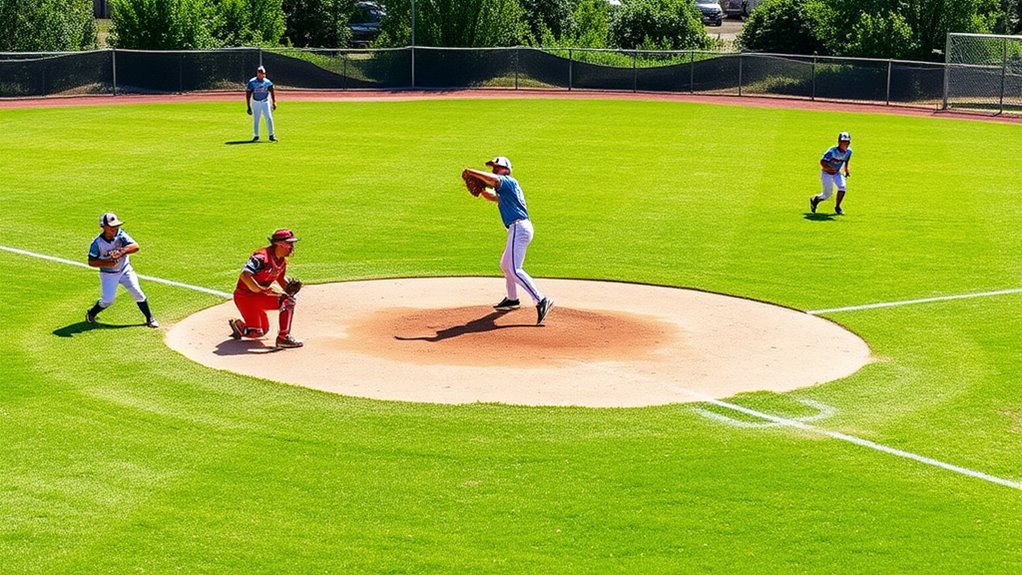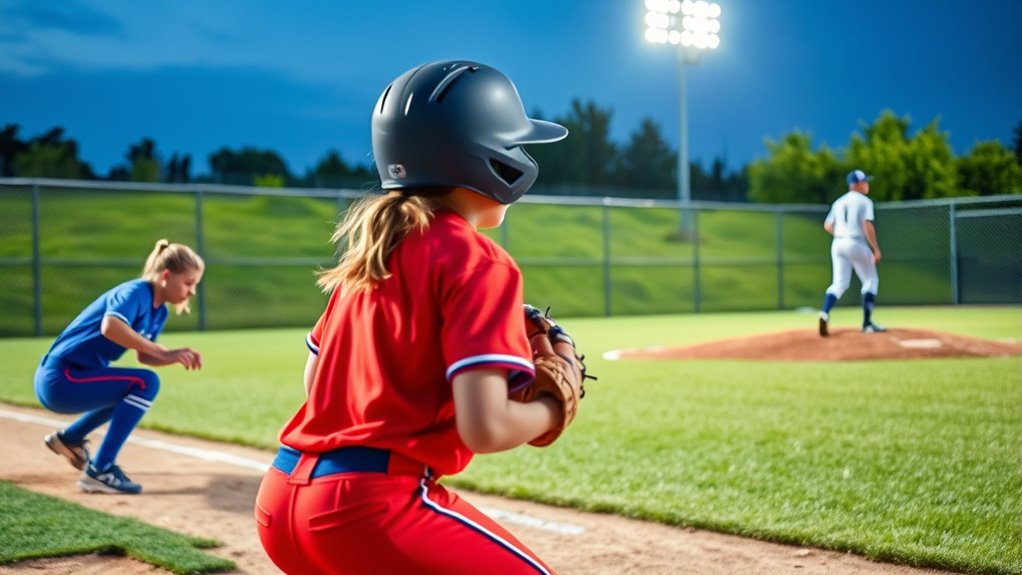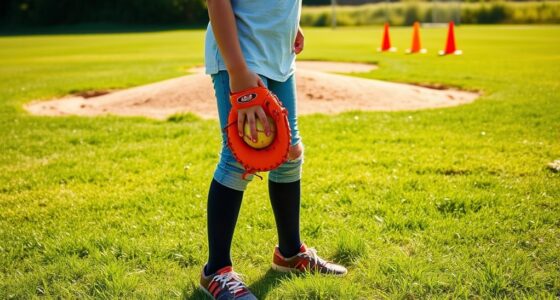In softball, knowing who’s on each position helps you play confidently. Infielders include first base, second base, shortstop, and third base, each with specific responsibilities like handling ground balls and quick throws. Outfielders cover left, center, and right fields, focusing on catching fly balls and making strong throws. Understanding these roles boosts your teamwork and skill. Keep exploring to learn more about each position’s unique demands and how they fit into the game.
Key Takeaways
- Infield positions include first base, second base, shortstop, and third base, each with specific defensive roles.
- Outfield positions—left, center, and right—cover large areas and require tracking fly balls.
- Essential skills for all positions include proper stance, quick reactions, and accurate throws.
- Gear like gloves, helmets, and cleats enhances safety and performance for new players.
- Understanding each position’s responsibilities promotes teamwork and helps beginners find their best fit.

Starting softball can feel overwhelming, especially when you’re trying to understand each player’s role on the field. It’s a lot to take in, but once you grasp the basics of each position, you’ll feel more confident during games. A good place to start is by learning about the infield and outfield positions, as well as the key skills needed for effective fielding. Focusing on fielding fundamentals is essential because they form the backbone of reliable defense. Proper stance, quick reactions, and accurate throws are skills you’ll develop over time, but knowing what each position requires helps you prepare mentally and physically.
When you’re new, it’s also important to have your softball gear essentials ready. Comfortable, well-fitting gloves, helmets, cleats, and protective gear like sliding pads or a face guard will keep you safe and improve your performance. Having the right gear makes it easier to focus on learning the game rather than worrying about discomfort or safety issues. As you step onto the field, remember that each position has specific responsibilities, but they all revolve around the same goal: stopping the ball and making the play.
Infield positions include first base, second base, shortstop, and third base. Each has unique demands. For example, first base is often the player who catches throws from teammates and needs to be quick to scoop up low throws. The second baseman and shortstop are key in turning double plays and fielding grounders, so quick hands and agility are vital. Third base, often called the “hot corner,” requires fast reflexes and strong throws, because balls hit hard down the line come your way often. Outfielders—left, center, and right—cover more ground and need excellent fielding fundamentals to track fly balls, catch them cleanly, and make accurate throws back to the infield.
Understanding these roles helps you see how teamwork comes into play. Each position has its strengths, and knowing where you fit best is part of the learning process. Additionally, practicing fielding fundamentals like proper stance and quick reactions can significantly improve your performance. Keep practicing your fielding fundamentals and stay prepared with your softball gear essentials, and you’ll gradually gain confidence in your role on the field. Remember, every seasoned player started as a beginner, so be patient with yourself as you learn the game and find your place among your teammates.
Frequently Asked Questions
How Do I Choose the Right Position for My Skills?
To choose the right position for your skills, consider your strengths and player versatility. If you’re quick and agile, positions like outfield or second base suit you well. If you prefer focusing on specific skills, position specialization like pitcher or catcher may be better. Try different roles during practice to see where you excel and feel most comfortable. This approach helps you find a position that matches your abilities and enhances your game.
What Equipment Is Necessary for Each Position?
When selecting equipment for each position, you’ll need specific gear to perform well and stay safe. Baseball gloves vary in size and design depending on whether you’re in the infield or outfield, so choose accordingly. Protective gear like helmets, masks, and pads are essential for safety, especially for catchers and batters. Make sure you have the right gloves and gear tailored to your position to improve your game and prevent injuries.
How Do Players Transition Between Different Positions?
Players pivot, pass, and position themselves quickly, practicing seamless switching between roles. As you shift, focus on fluid base running and solid defensive strategies, which help you adapt smoothly. You’ll learn to read plays, reposition rapidly, and communicate clearly. With consistent practice, your agility improves, making position changes more natural. Embrace the challenge, stay flexible, and remember that mastering movement boosts your confidence and contributes to the team’s success.
Are There Specific Training Drills for Each Position?
You can improve your skills by using specific training drills tailored to each position. Focus on fielding strategies like ground ball drills for infielders and fly ball practice for outfielders. Incorporate base running tips, such as sprinting from the base and sliding techniques, into your routine. These targeted drills help you become more confident, faster, and more effective on the field, regardless of your position.
What Are Common Mistakes Beginners Make in Each Position?
They say practice makes perfect, but beginners often struggle with fielding fundamentals and batting strategies. Common mistakes include not keeping their eyes on the ball, poor footwork, and hesitation in catching or throwing. In batting, swinging too early or too late can cost hits. Focus on steady practice, stay alert, and refine your skills to avoid these pitfalls and improve your overall game.
Conclusion
So, now that you know the positions, you’re practically a softball pro, right? Just remember, even with all this info, the game’s still full of surprises. Sometimes, the hardest position is simply trusting your instincts—and maybe not overthinking it. After all, who needs a perfect play when you can just say you’re “on first”? Keep practicing, and soon you’ll realize that sometimes, the only thing more unpredictable than softball is how much you’ll love playing it.









